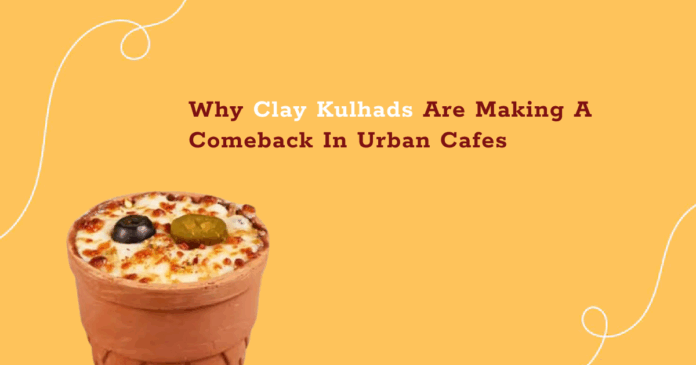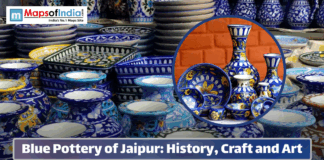Urban cafes across India are adapting the clay-made kulhad as a new trend. They are replacing rustic plastic cups. These traditional cups, once a staple at roadside tea stalls, are now becoming a symbol of sustainability, nostalgia and cultural pride. From Mumbai’s hip bistros to Delhi’s artisanal coffee shops, kulhads are redefining the cafe experience. The urban cafes are looking toward kulad as a new trend. But in rural India, kulads have been ruling for centuries.
Reasons for the Kulhad Comeback
- Embracing Sustainability
Kulhads are eco-friendly. Biodegradable alternatives to plastic and paper cups. Aligning with the global push for sustainability. India generates 3.5 million tons of plastic waste each year. Cafes are under pressure to become more pro-environmental. Kulhads made from natural clay and fired in kilns decompose without harm.
Chains like Chai Sutta Bar use kulhads to serve tea, marketing them as zero-waste vessels that resonate with eco-conscious Gen Z patrons. 60% of urban cafes have adopted sustainable serveware reduction in single-use plastic waste in participating outlets.
- Reviving Cultural Nostalgia
Kulhads evoke memories of traditional chai stalls and railway journeys. This gives a nostalgic escape in fast-paced urban settings. Urban youth crave authentic experiences, and kulhads indirectly connect them to India’s rural roots. This enhances the sensory appeal of sipping chai or lassi.
Cafes like The Chai Theka in Bengaluru decorate with vintage props and serve chai in kulhads. Which creates an Instagram-worthy “desi” vibe. Social media posts with this desi vibes have gained an enormous following. People to avoid FOMO are also following this trend.
- Enhancing Sensory Experience
Kulhads structure the smell of sola, and its structure enhances the taste of the product being served. This gives a sensory experience to customers, making them feel they have tasted something authentic.
Customers at Delhi’s Jugmug Thela rave about kulhad chai’s unique taste. They are often posting about this on social media, too. A study has found that the shops that claim authenticity get more customers than other shops.
4. Supporting Local Artisans
Urban cafes buy kulad from local shops, which increases business opportunities. Also, it gives support to local communities. This creates a sustainable supply chain. This provides livelihoods for local workers while appealing to consumers who want an authentic experience.
Mumbai’s Cafe Arpan partners with Gujarat’s Kutch potters to show the process of making kulad on their social media handle. According to a study, there has been an increase in the business of potters as this surge of kulad has been seen in cafes.
- Aligning with Health Consciousness
Kulhads are known as hygienic and chemical-free. Which appeals to health-conscious urban population. Fired at high temperatures in kilns, kulhads are naturally sterile, offering a safer alternative to mass-produced plastic cups.
Cafes like Tea Trails in Hyderabad market kulhads as “pure clay” vessels, attracting yoga enthusiasts and wellness-focused patrons.
6. Boosting Social Media Appeal
Kulhads are photogenic, fueling social media posts that make cafes go viral among Gen Z and millennials. Their rustic aesthetic, paired with colourful beverages, creates shareable content, driving free marketing for cafes.
A viral TikTok video of kulhad latte art at Chennai’s Brew Room garnered 2 million views. Attracting many customers. There has been a surge in people going to Kulad cafes after the post on social media started becoming viral.
- Cost-Effective for Cafes
Kulhads are affordable for cafes to procure. Offering a sustainable yet budget-friendly option compared to branded paper cups. Small-scale cafes, which are competing with chains, can reduce costs while enhancing their eco-friendly brand image.
Chai Sutta Bar’s franchise model emphasizes kulhads for low-cost, high-impact branding with franchisees reporting strong ROI. It’s also reusable. So it’s a one-time purchase.
- Government and Policy Support
Initiatives like Swachh Bharat and bans on single-use plastics encourage cafes to adopt kulhads as eco-compliant service ware. Government incentives and public campaigns create a favourable environment for sustainable practices.
There are many cafes seen in urban spaces, which are possible because of government support. They might be in a park or a small truck. It has also helped in reducing pollution.
- Appealing to Urban Minimalism
Kulhads fit the minimalist aesthetic popular among urban youth. Those who favour simple and natural designs over flashy branding. Their unpolished and earthy look complements cafe decor and creates a cohesive, trendy vibe that resonates with modern tastes.
Bangalore’s Third Wave Coffee uses kulhads to match its Scandinavian-inspired interiors, attracting design-savvy patrons. This minimalist trend has also become famous on social media.
- Fostering Community Connection
Kulhads spark conversations about sustainability and heritage and build a sense of community among cafe goers. They act as icebreakers, encouraging patrons to share stories about chai stalls or eco living, enhancing the cafe experience.
Many cafes are hosting kulad talks in urban spaces. These are helping toad community building, and with the help of social media, this trend is becoming viral.
Challenges and Opportunities
Challenges
There a supply chain issues. Rural artisans struggle to meet urban demand. Kulhads break easily. They require careful handling, which creates a challenge for small shop owners. Also, those shops are not able to compete with artistic kulad.
Only 50% of urban youth know kulhads’ environmental benefits. So, many cafes are still using plastic cups. Those mass-produced plastic and paper cups are still favoured in many cafes. Big cafes like Starbucks make it a fashion statement to carry plastic cups.
Opportunities
Programs like Skill India can train potters, which increases supply and quality. Collaboration between cafe owners and local pottery communities to increase business for both. Partnerships with NGOs like Khamir can streamline kulhad sourcing, which benefits artisans.
Making use of social media. Inviting influences to the cafe and pottery. This can also be seen as an opportunity to expand this culture abroad.
The Future of Kulhads in Urban Cafes
We need to aim for wider adoption of this culture. 70% of urban cafes may use kulhads because of the plastic ban, says a study. Kulhads could enter international cafes. Making this trend worldwide.
Using social media and e-commerce platforms to increase sales. And also making it available in every major city of India, bridging the distance between the potter and cafes. Kulhads will remain symbols of India’s heritage, which blends sustainability with style.
Conclusion
Clay kulhads are making a comeback in urban cafes. Given the vibes of nostalgia and sensory appeal. Kulads have their unique charm and environmental appeal. A recent study shows reduced plastic waste and increased cafe sales, showing their impact. Challenges like supply chain gaps exist. But opportunities through artisan support and digital outreach abound. As urbanites sip from these earthy cups. Kulhads weave a story of tradition and innovation. Proving that small vessels can spark big change.





